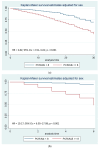C-Reactive Protein to Albumin Ratio Predicts Early Mortality in Hospitalized Older Patients, Independent of the Admission Diagnosis
- PMID: 40573094
- PMCID: PMC12196520
- DOI: 10.3390/nu17121984
C-Reactive Protein to Albumin Ratio Predicts Early Mortality in Hospitalized Older Patients, Independent of the Admission Diagnosis
Abstract
Background: Malnutrition and systemic inflammation are prevalent among older hospitalized patients and are associated with increased morbidity and mortality. The C-reactive protein to albumin (CRP/Alb) ratio reflects inflammatory and nutritional status and may serve as a useful prognostic biomarker. Objective: To evaluate the prognostic value of the CRP/Alb ratio in predicting early in-hospital mortality in a large cohort of elderly patients, independent of the admission diagnosis. Methods: This retrospective observational study examined the clinical data and serum values of serum C-reactive protein (CRP), albumin, and the CRP/Alb ratio, detected at the time of admission, in a cohort of 2780 patients over sixty-five admitted to the Internal Medicine and Aging Department of the "Policlinico Riuniti" University Hospital Trust in Foggia, between 2019 and 2024. The predictive power of the CRP/Alb ratio for 7- and 30-day hospital mortality was evaluated by ROC curve analysis, Cox regression, and Kaplan-Meier survival analysis. Results: In total, 444 patients died (16%) during their in-hospital stay. The CRP/Alb ratio was significantly higher among deceased subjects (p < 0.001) than in non-deceased patients. The CRP/Alb ratio was strongly associated with mortality, particularly during the first 7 days from admission (AUC = 0.888). A CRP/Alb ratio >8 was an independent and significant predictor of mortality within 30 days (HR = 3.82, 95% CI: 2.91-5.01), but particularly within the first 7 days from hospitalization (HR = 10.17, 95% CI: 6.05-17.08). Similar results were observed among re-hospitalized patients. Conclusions: The CRP/Alb ratio is a significant and independent predictor of early in-hospital mortality in elderly patients, regardless of admission diagnosis. A threshold value >8 identifies individuals at high risk, particularly within the first week of hospitalization. This simple, cost-effective biomarker may support early risk stratification and guide targeted interventions in geriatric care.
Keywords: C reactive protein; PCR/Alb ratio; albumin; inflammation elderly; malnutrition; mortality.
Conflict of interest statement
The authors declare no conflicts of interest.
Figures


Similar articles
-
C-Reactive Protein/Albumin Ratio vs. Prognostic Nutritional Index as the Best Predictor of Early Mortality in Hospitalized Older Patients, Regardless of Admitting Diagnosis.Nutrients. 2025 Sep 8;17(17):2907. doi: 10.3390/nu17172907. Nutrients. 2025. PMID: 40944295
-
Dynamic association of serum albumin changes with inflammation, nutritional status and clinical outcomes: a secondary analysis of a large prospective observational cohort study.Eur J Med Res. 2025 Jul 28;30(1):679. doi: 10.1186/s40001-025-02925-5. Eur J Med Res. 2025. PMID: 40717075 Free PMC article.
-
Prognostic Value of Blood Urea Nitrogen to Albumin Ratio in Elderly Critically Ill Patients with Acute Kidney Injury: A Retrospective Study.Medicina (Kaunas). 2025 Jul 8;61(7):1233. doi: 10.3390/medicina61071233. Medicina (Kaunas). 2025. PMID: 40731862 Free PMC article.
-
Biomarkers as point-of-care tests to guide prescription of antibiotics in people with acute respiratory infections in primary care.Cochrane Database Syst Rev. 2022 Oct 17;10(10):CD010130. doi: 10.1002/14651858.CD010130.pub3. Cochrane Database Syst Rev. 2022. PMID: 36250577 Free PMC article.
-
Intravenous magnesium sulphate and sotalol for prevention of atrial fibrillation after coronary artery bypass surgery: a systematic review and economic evaluation.Health Technol Assess. 2008 Jun;12(28):iii-iv, ix-95. doi: 10.3310/hta12280. Health Technol Assess. 2008. PMID: 18547499
Cited by
-
Identification of Candidate Inflammatory-Nutritional Blood Biomarkers for Cachexia and Muscle Depletion in Polish Chronic Heart Failure Patients.J Cardiovasc Transl Res. 2025 Jul 22. doi: 10.1007/s12265-025-10664-5. Online ahead of print. J Cardiovasc Transl Res. 2025. PMID: 40694177
References
-
- World Health Organization [(accessed on 6 May 2025)]. Available online: https://www.who.int/news-room/fact-sheets/detail/ageing-and-health.
-
- Volkert D., Beck A.M., Cederholm T., Cereda E., Cruz-Jentoft A., Goisser S., de Groot L., Großhauser F., Kiesswetter E., Norman K., et al. Management of Malnutrition in Older Patients—Current Approaches, Evidence and Open Questions. J. Clin. Med. 2019;8:974. doi: 10.3390/jcm8070974. - DOI - PMC - PubMed
Publication types
MeSH terms
Substances
LinkOut - more resources
Full Text Sources
Research Materials
Miscellaneous

